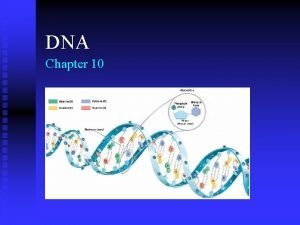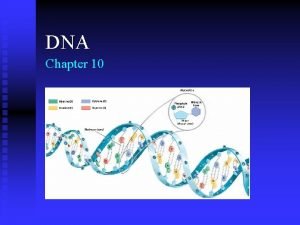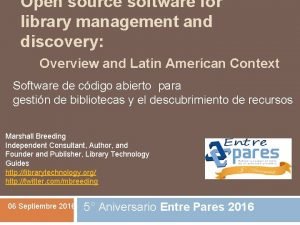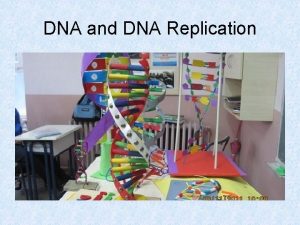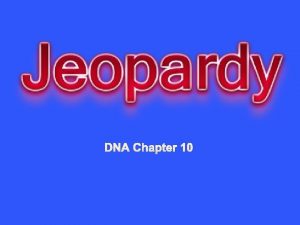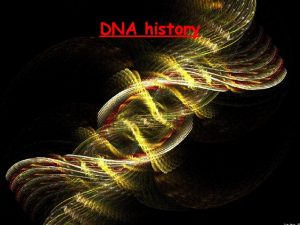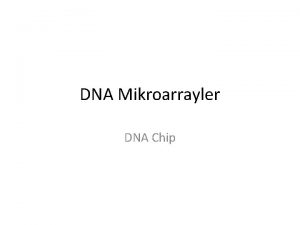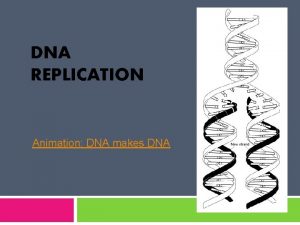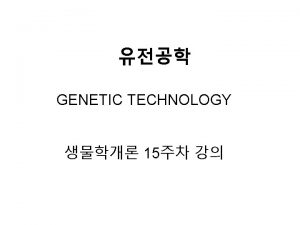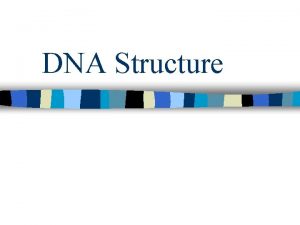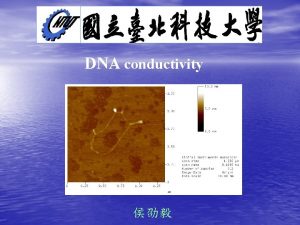The Discovery of DNA as the Source of































- Slides: 31

The Discovery of DNA as the Source of Heredity

The human genome project which has decoded the base sequence for the whole 6 feet of the human genome requires a data warehouse (pictured) to store the information electronically. Scientists have programmed nearly 500, 000 DVD’s worth of data into 1 gram of DNA!

Confirmation of DNA 1952 | 1969 Hershey • Hershey & Chase – classic “blender” experiment – worked with bacteriophage • viruses that infect bacteria – grew phages in 2 media, radioactively labeled with either Why use Sulfur • 35 S in their proteins vs. Phosphorus? • 32 P in their DNA – infected bacteria phages

Protein coat labeled with 35 S DNA labeled with 32 P T 2 bacteriophages are labeled with radioactive isotopes S vs. P Hershey & Chase bacteriophages infect bacterial cells are agitated to remove viral protein coats Which radioactive marker is found inside the cell? Which molecule carries viral genetic info? 35 S radioactivity found in the medium 32 P radioactivity found in the bacterial cells

Blender experiment • Radioactive phage & bacteria in blender – 35 S phage • radioactive proteins stayed in supernatant • therefore viral protein did NOT enter bacteria – 32 P phage • radioactive DNA stayed in pellet • therefore viral DNA did enter bacteria – Confirmed DNA is “transforming factor”

7. 1. 10 Analysis of results of the Hershey and Chase experiment providing evidence that DNA is the genetic material. http: //highered. mheducation. com/olcweb/cgi/pluginpop. cgi? it=swf: : 535: : /sites/dl/free /0072437316/120076/bio 21. swf: : Hershey%20 and%20 Chase%20 Experiment

Nucleic Acids • There are TWO types of nucleic acids in living organisms: n. DNA (Deoxyribo. Nucleic Acid) – the instructions for creating an organism are stored in digital code along coiled chains of DNA n RNA (Ribo. Nucleic Acid) – reads the information in DNA and transports it to the protein-building apparatus of the cell DNA and RNA is found in the nucleus of cells!!!!

Nucleotide Each nucleotide is made up of: Ø A 5 carbon sugar Ø a phosphate group Ø a nitrogenous base DNA is slightly acidic and composed of large amounts of phosphorus and nitrogen. The phosphate group is negatively charged.

Directionality of DNA • You need to number the carbons! nucleotide PO 4 N base – it matters! 5 CH 2 This will be IMPORTANT!! 4 O 1 ribose 3 OH 2

DNA v. RNA • DNA contains the sugar DEOXYRIBOSE whereas RNA contains the sugar RIBOSE. The only difference between these two sugars is the lack of oxygen at carbon 2 in deoxyribose – this accounts for its name. DNA RNA

DNA nitrogen bases Purines have a double-ringed structure. Pyrimidines have a single-ringed structure.

RNA nitrogen bases • PURINES 1. Adenine (A) 2. Guanine (G) • PYRIMIDINES 3. Uracil (U) 4. Cytosine (C) Which base is found in DNA that is NOT found in RNA?

Erwin Chargaff 1947 • DNA composition: “Chargaff’s rules” – varies from species to species – all 4 bases not in equal quantity – bases present in characteristic ratio • humans: A = 30. 9% T = 29. 4% G = 19. 9% C = 19. 8% That’s interesting! What do you notice? Rules A = T C = G

DNA v. RNA

DNA v. RNA DNA Structure Compared to RNA Structure DNA RNA Sugar Deoxyribose Ribose Bases Adenine, guanine, thymine, cytosine Adenine, guanine, uracil, cytosine Strands Double stranded with base Single stranded paring Helix Yes No

DNA Structure Double Helix “Rungs of ladder” Nitrogen Base (A, T, G or C) “Legs of ladder” Phosphate & Sugar Backbone

Covalent bond: phosphodiester bond 5 O Hydrogen bonds 3 3 P 5 O O C G 1 P 5 3 2 4 4 2 3 P 5 1 O T A 3 O P 3 5 O 5 P P

Chargaff’s Rule • Adenine must pair with Thymine • Guanine must pair with Cytosine T A G C

Nucleotide Pairing Complimentary base pairing causes the diameter of the DNA helix to remain constant ie: 2 nm. The large number of hydrogen bonds between DNA strands account for its structural stability.

Antiparallel strands The phosphate group of one nucleotide is linked to the sugar of another via a PHOSPHODIESTER BOND. The end that terminates in a PHOSPHATE GROUP is labelled the 5’ end. The end that terminates in a HYDROXYL GROUP is labelled the 3’ end. The bond that links the sugar to its nitrogenous base is referred to as a GLYCOSYL BOND. Complimentary strands are said to be ANTIPARALLEL.

Nucleic Acids Hydrogen bonds 5’ P G C P P C G A T T A P P 3’ P P T A

Organization of Genetic Material

Histones • Eukaryotic cells contain more than 2 m of DNA (over 6 billion base pairs) • DNA is wound twice around 8 histone proteins with an additional histone holding it all together. • This is called a nucleosome • This is further wound into chromatin fibres

Ø DNA – double helix Ø Rosalind Franklin and Maurice Wilkins used Xray diffraction to determine structure of DNA. Pattern was presented to James Watson and Francis Crick.

X-Ray Diffraction of DNA

Ø 1953 - Watson and Crick built model of DNA using work of Chargaff and Rosalind Franklin Ø Nobel prize- 1962 – Watson, Crick, Wilkins Ø Proposed right-handed model of DNA i. e. turns in clockwise direction Ø Makes one complete turn every 10 base pairs.

Ø Sugar + phosphate = backbone Ø 2 strands run antiparallel i. e. one strand runs 5’ to 3’ – other strand 3’ to 5’ Ø i. e. 5’-ATGCCGTTA-3’ 3’-TACGGCAAT-5’ This is called complimentary base pairing


Structure • Watson & Crick of DNA 1953 | 1962 – developed double helix model of DNA • other leading scientists working on question: – Rosalind Franklin – Maurice Wilkins – Linus Pauling Franklin Wilkins Pauling

Rosalind Franklin (1920 -1958)

Scientific History T. H. Morgan (1908): genes are on chromosomes Frederick Griffith (1928): a transforming factor can change phenotype Avery, Mc. Carty & Mac. Leod (1944): transforming factor is DNA Erwin Chargaff (1947): Chargaff rules: A = T, C = G Hershey & Chase (1952): confirmation that DNA is genetic material Watson & Crick (1953): determined double helix structure of DNA Meselson & Stahl (1958): semi-conservative replication
 Section 10-1 review discovery of dna
Section 10-1 review discovery of dna Discovery of dna section 10-1 review
Discovery of dna section 10-1 review Open source discovery
Open source discovery Replication process
Replication process Dna polymerase function in dna replication
Dna polymerase function in dna replication Chapter 11 dna and genes
Chapter 11 dna and genes Bioflix activity dna replication lagging strand synthesis
Bioflix activity dna replication lagging strand synthesis Coding dna and non coding dna
Coding dna and non coding dna Diễn thế sinh thái là
Diễn thế sinh thái là V. c c
V. c c Vẽ hình chiếu vuông góc của vật thể sau
Vẽ hình chiếu vuông góc của vật thể sau Phép trừ bù
Phép trừ bù Hươu thường đẻ mỗi lứa mấy con
Hươu thường đẻ mỗi lứa mấy con Lời thề hippocrates
Lời thề hippocrates Chụp phim tư thế worms-breton
Chụp phim tư thế worms-breton đại từ thay thế
đại từ thay thế Quá trình desamine hóa có thể tạo ra
Quá trình desamine hóa có thể tạo ra Công thức tính độ biến thiên đông lượng
Công thức tính độ biến thiên đông lượng Thế nào là mạng điện lắp đặt kiểu nổi
Thế nào là mạng điện lắp đặt kiểu nổi Dot
Dot Bổ thể
Bổ thể Vẽ hình chiếu đứng bằng cạnh của vật thể
Vẽ hình chiếu đứng bằng cạnh của vật thể Thế nào là sự mỏi cơ
Thế nào là sự mỏi cơ Phản ứng thế ankan
Phản ứng thế ankan Môn thể thao bắt đầu bằng chữ f
Môn thể thao bắt đầu bằng chữ f Sự nuôi và dạy con của hổ
Sự nuôi và dạy con của hổ Thiếu nhi thế giới liên hoan
Thiếu nhi thế giới liên hoan Hát lên người ơi alleluia
Hát lên người ơi alleluia điện thế nghỉ
điện thế nghỉ Một số thể thơ truyền thống
Một số thể thơ truyền thống Trời xanh đây là của chúng ta thể thơ
Trời xanh đây là của chúng ta thể thơ
